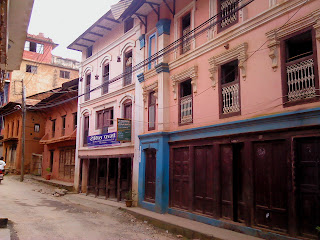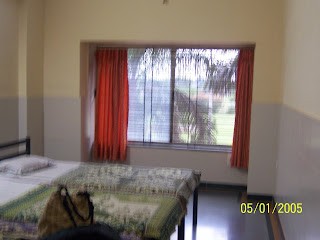....also known as the Taj Mahal of Nepal. It was built buy a General about a century ago in memory of his deceased wife. They said it would be a 5 hour trek. It took us 9 and a half hours. The Nepalis are highlanders..seasoned to walk on the mountains. We saw fifthgraders prancing back from school laughing at us as we panted and puffed louder than the big bad wolf.
Yet I'd recommend it to everyone visiting Palpa. It shouldn't be a challenge to anyone who climbs a flight of stairs once a day. It's better to travel in groups since there are no guides or directions.
The trek to the palace is downhill and from is uphill. It took us more time to go downhill as we didn't know the route ...which was very unclear.....and we just didn't know if we were getting there. The trek begins with a steep downhill walk over a very rocky path. The people are really friendly and hospitable. The locals guided us whenever we came across them. The route moves down wooded hills and terraced farms....which I had always wanted to get close to....you can't run down them as I always thought :)...until you finally reach a stream...with ice cold water. This is the mid point to our destination. The stream crosses through the path at many places as you move downhill. The cold water soothed our aching feet. We walked through green forests with insects buzzing in the backdrop. All you can see for the next four hours are green trees and rocks. You tend to forget there's a world outside those hills. You pass by two small villages where the locals sell biscuits etc and have a couple of eateries offering simple food and drinks.
It's difficult finding a loo...I don't think there are any on the way. One can be as innovative as he likes while in the woods.
The stream forms rapids and tiny waterfalls along the way. You get to walk right through them at times. You cross a creaky bridge and walk downhill through more trees and springs till you finally get to the palace.
On our trip there was a landslide midway. We risked our necks and clambered over it to the other side.
One meets the local people at the beginning and the end of the trip. It's very hard finding people to guide you mid way. As a rule of thumb...keep going down in a straight path.
The palace is not much to write about. It's like a big blue country manor. You have to show yourself in, unbolt the doors walk through the empty rooms and bolt the doors on your way out. The view from the balcony is breathtaking with the Narayani river flowing right beside the palace. How the General built the big structure in the middle of the forests a hundred years ago is a wonder. With no motorable roads people had to trek through dense woodland with bricks and mortar and wood .....seems impossible.
There are eateries around the palace where we ate a bowl of noodles before the trek up. Towards the end of the trek we met someone who we had encountered on our way down. He said he hadn't expected us to come back so soon. Coming from a highlander..that was a compliment...we boast of how fast we walk whenever we can now.
My description of the palace shouldn't discourage one from going there. The trekking route is excellent. The palace is good...just don't expect the Taj Mahal.
Back in civilization....we hogged on pastries and noodles and momos at Nanglo's and headed back to the hotel to enjoy a well earned sleep.
Yet I'd recommend it to everyone visiting Palpa. It shouldn't be a challenge to anyone who climbs a flight of stairs once a day. It's better to travel in groups since there are no guides or directions.
The trek to the palace is downhill and from is uphill. It took us more time to go downhill as we didn't know the route ...which was very unclear.....and we just didn't know if we were getting there. The trek begins with a steep downhill walk over a very rocky path. The people are really friendly and hospitable. The locals guided us whenever we came across them. The route moves down wooded hills and terraced farms....which I had always wanted to get close to....you can't run down them as I always thought :)...until you finally reach a stream...with ice cold water. This is the mid point to our destination. The stream crosses through the path at many places as you move downhill. The cold water soothed our aching feet. We walked through green forests with insects buzzing in the backdrop. All you can see for the next four hours are green trees and rocks. You tend to forget there's a world outside those hills. You pass by two small villages where the locals sell biscuits etc and have a couple of eateries offering simple food and drinks.
It's difficult finding a loo...I don't think there are any on the way. One can be as innovative as he likes while in the woods.
The stream forms rapids and tiny waterfalls along the way. You get to walk right through them at times. You cross a creaky bridge and walk downhill through more trees and springs till you finally get to the palace.
On our trip there was a landslide midway. We risked our necks and clambered over it to the other side.
One meets the local people at the beginning and the end of the trip. It's very hard finding people to guide you mid way. As a rule of thumb...keep going down in a straight path.
 |
| a village en route |
There are eateries around the palace where we ate a bowl of noodles before the trek up. Towards the end of the trek we met someone who we had encountered on our way down. He said he hadn't expected us to come back so soon. Coming from a highlander..that was a compliment...we boast of how fast we walk whenever we can now.
My description of the palace shouldn't discourage one from going there. The trekking route is excellent. The palace is good...just don't expect the Taj Mahal.
 |
| the palace |






























